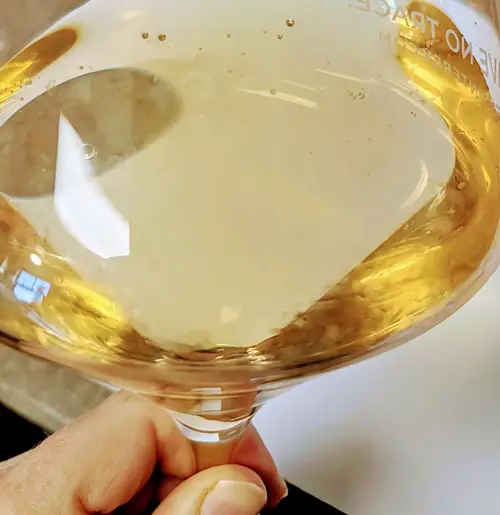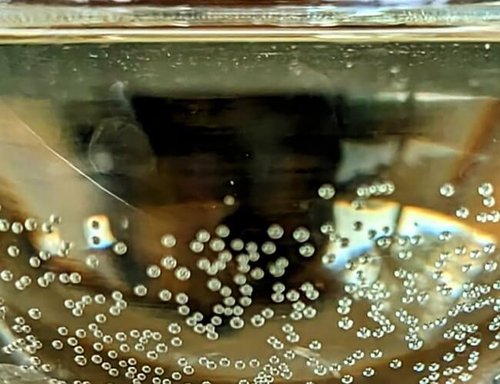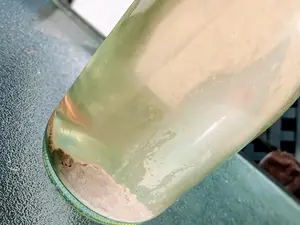
Inside each white wine bottle, the wine’s in a state of pause somewhere between grape juice and vinegar. But how do you know if it’s gone bad?
All white wines will eventually go bad. Here are three quick steps to tell if your wine is bad: 1) look at it. A burnt yellow, brownish, or murky color is a sign that the wine is bad. 2) Smell your wine. If your white wine smells like vinegar, garlic, or nuts it’s bad. 3) Take a sip. Bad white wines will taste muted, alcoholic, or worse.
Here’s a 3-step process on how to tell if your white wine is bad.
Is My White Wine Bad?
White wines that have gone bad will change color from a light straw or pale yellow to deep gold with subtle brown notes. When you take a sip of a bad white wine, it will taste nutty, flat, and a little vinegary.
The bright fruits will seem muted – if you can taste them at all. Full-bodied white wines, like Chardonnay, are generally more resilient than delicate white wines like Pinot Grigio.
Step 1: Look at the wine

The first step to determining if your white wine is bad is a visual inspection. If it is in a clear bottle, you can likely tell that something is amiss by simply looking at the wine.
Look for: A change in color.
White wines in clear bottles that have gone bad will turn a deep, burnt yellow color. They lack the vibrancy of younger wines.
Helpful Tip: You won’t be able to judge your white wine’s color if it’s in an opaque or dark green bottle. Pour out a small amount of the suspect wine and look for visual cues in your glass.
Now, some wines are made this way stylistically, but the majority of white wines bottled in clear glass are intended for early drinking (dessert wines notwithstanding).
Look For: Cloudy wine
White wines that aren’t crystal clear, but rather have a cloudy tinge to them indicate that it’s probably off. It could an indicator of microbial spoilage.
Helpful Tip: Some natural wines, or low-intervention wines are more prone to cloudiness and you may like this style. There’s nothing in the bottle that will harm you if you’re okay with cloudy wine. Also, petnat wines, or petillant natural sparkling white wines, will always be cloudy due to sediment from yeast cells. This is a natural part of the winemaking style.
Look For: Bubbles
You may see tiny bubbles in your wine. This is a sign that the winemaker didn’t sterile filter the wine or that the wine didn’t fully complete fermentation. Some white wines, like Moscato d’Asti and New Zealand Sauvignon Blanc, have a tiny bit of spritz to help lift up their aromatic fruit profile, but a Chardonnay shouldn’t have any bubbles.

It’s safe to drink wine with a little spritz, but you may dislike the sensation.
Side Note: I recently had a Torrontes white wine from Argentina under a screwcap. When I twisted off the cap the bottle gave a noticeable pop with a slight spritz. This was a sign that the wine had some yeast activity from an incomplete fermentation or that the wine wasn’t sterile filtered. I still drank the wine and it was fine, but it did surprise me! (psst…Never heard of Torrontes wine? Go check it out.)
Step 2: Next is the sniff test

Most of the time when you go to smell your wine will be the first sign that something is off.
This is the reason that waiters pour you a small sample of a bottle at restaurants. It gives you the opportunity to swirl and smell to see if you can detect any off odors. Here are a few common signs your white wine has gone bad:
Smell for: Vinegar or Acetic Acid.
Eventually, every wine will turn into vinegar.
This is caused by bacteria. If your wine smells like vinegar, tangy, or even pickles or sauerkraut, it’s a sign that your white wine has started to turn.
Does your white wine smell like vinegar? A white wine that smells like vinegar is clearly rancid and bad.
Smell For: Oxidation
Not all bad white wines will smell like vinegar. Oxidation happens when your white wine gets exposed to oxygen, for example, leftover wine or a faulty cork.
Oxidized wines smell nutty and can have a bruised apple aroma.
Left long enough, your white wine may start to develop caramel or praline notes.
Does your white wine seem muted when you smell it?
Not only are the fresh fruits more of a dried nature, but you may not be able to smell much of anything in a bad white wine that’s oxidized.
Helpful Tip: Some white wines go through deliberate oxidation, for example Amontillado and Oloroso Sherries. If you want to taste complex oxidized wines, pick up a bottle of these unique whites the next time you’re at your local bottle shop. Here’s a post on Amontillado Sherry and what makes this Spanish white wine so unique.
Smell For: Reduction

If you have a white wine that smells like garlic or cabbage, then you’re smelling a wine fault called reduction.
You may detect burnt rubber, rotten egg, canned asparagus, boiled cabbage, or rotting garbage. The good news is that swirling your wine vigorously, decanting it, or leaving it open in the refrigerator overnight can help get rid of reduction aromas.
Oxygen binds with most forms of these offensive molecules and they quickly dissipate.
Yay chemistry!
Fun wine fact: Some types of wine grapes are more prone to reduction than others. Syrah’s a problematic grape when it comes to reduction, as is Sauvignon Blanc.
Step 3: Take a small sip

The ultimate test to see if your white wine is bad is to take a sip and taste it. Don’t worry, nothing in a bad wine can physically hurt you, but it may not taste very good.
Helpful Tip: Stand next to your kitchen sink or have a spit cup next to you in case your white wine is disgusting. It happens. Nothing in the wine can hurt you, so don’t worry about getting sick.
Taste your white wine.
Concentrate on the flavors in your white wine. If your white wine tastes like nail polish remover, rancid nuts, vinegar, matchstick, rodent feces, barnyard, or mold, then it’s bad, and you need to pour it down the sink.
If all you taste is alcohol, and there’s no fruit, or it’s muted, then your white wine has passed its drinking window. Grab another bottle.
Feel your white wine in your mouth.
If you detect a noticeable spritz in your glass, it could be from an incomplete fermentation. This won’t hurt you if you otherwise like the white wine and want to continue drinking it. You’ll be fine.
Helpful Tip: Check out more about how wine fermentation works here.
What Causes White Wines to Go Bad?

Faulty winemaking, exposure to oxygen, and time can all be reasons that your white wine goes bad. Faulty winemaking can happen with poor winery sanitation or problems with the bottling line when a closure doesn’t work properly.
Poor winery sanitation can lead to microbial spoilage in your white wine.
Your white wine can get exposed to oxygen with a faulty closure or if you have leftover wine that sits for more than a few days.
Finally, all wines will fade with time and lose their fruity flavors. Most wines are made to be enjoyed soon after bottling, so drink up!
Can White Wine Go Bad in the Fridge?

White wine can go bad in the fridge. If you have an unopened white wine with a natural cork and leave it in the fridge for an extended period of time (months), this will dry out the cork and could cause leakage and air to get into the wine causing your white wine to oxidize (look for clues like a deeper color and Sherry notes).
Helpful Wine Storage Tip: Here’s a quick guide: Do you refrigerate wine?
If you have leftover white wine stored in the refrigerator, it will keep for a few days, but ultimately the oxygen will cause your wine to go bad.
Helpful Tip: Here’s a great post that covers how to properly store your leftover white wine and how you can extend your wine’s drinkability for as long as possible. (As someone who always has leftover wine, this is useful information to know.)
How to Learn about Oxidized White Wines: A Fun At-Home Experiment

If you are just getting into wine and really want to learn about how wine faults work, then this experiment is perfect for you and will teach you how to identify an oxidized white wine.
- Go to your local bottle shop and buy two bottles of the cheapest white wine you can find. A Pinot Grigio or generic white table wine work well.
- Take one bottle and pour half of it off (you can drink it or use it for cooking).
- Cover the bottle opening with a paper towel and a rubber band.
- Set the bottle aside in a place where it can’t be disturbed (and no one will accidentally drink it).
- Wait 2 weeks.
- After 2 weeks, take the open bottle and the unopened bottle and pour yourself 1 glass of wine from each bottle.
What do you notice?
- Step 1: Look at the color of the wine. The wine that’s been open for 2 weeks will have a darker color.
- Step 2: Smell each wine. The wine that’s been open won’t have much of a smell to it or will smell slightly of nuts, bruised apples, or vinegar.
- Step 3: Taste each wine. The wine that’s been opened will tastes muted, like vinegar, acid, and alcohol. You won’t be able to taste much fruit if any.
This experiment is the perfect way to train your senses to detect oxidized wines.
Final Thoughts – Trust your senses!

Your eyes, nose, and mouth all work to give you clues that tell you if a white wine has gone bad.
Start with your eyes and examine the wine’s color.
- Is the wine pale lemon or dirty yellow?
- Is the wine cloudy?
Move to your nose.
- Does your white wine smell like fresh fruit or bruised apple and nuts?
- Do you notice garlic or cabbage?
Last, take a sip.
- Do you taste vibrant fruit like lemon and nectarine, or does it taste like nuts or mold?
Always trust your senses.
If something seems off in your white wine, then it’s gone bad and the best thing to do is to pour it out and open a new bottle.
Thirsty for More?

If you’re worried about wine faults, check out this post on cork taint. Yes, cork taint is a thing (but not if you buy wines with screwcaps 🙂
And if you’re thinking that your leftover wine’s gone bad, then you need to check out this post on how to store leftover wine. It’s a great resource that helps you extend the life of leftover wine and save you from the pain of pouring out wines past their prime. Sadness.



